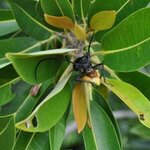Ecology & Zoology

Forcepflies, commonly known as earwigflies, because the males have a large genital forceps that resembles the cerci of earwigs, are part of a family that was widespread from Australia to Antarctica and over the Americas during the Jurassic period and extant members are rare now.
Meropeidae, one of the smallest and least known families of Mecoptera, only has two living species, the North American Merope tuber and the Western Australian Austromerope poultoni (the fossil species is Boreomerope antiqua). The biology of both of these species is essentially unknown, and their larvae have…

President Obama recently got some ridicule for hastily claiming he loved skeet shooting and therefore was not against sportsmen when he wanted to tell Americans they couldn't be trusted to decide how many bullets to buy for their guns.
That he was simultaneously offering bombs and fighter jets to terrorists in Egypt while he didn't trust his own citizens with small arms ammunition was not lost on his critics.
Satire aside, the problem with his logic was that the US Constitution does not actually limit guns to skeet shooting, even if he thinks it does. The Second Amendment's right to bear…

Most mammals, including humans, see in stereo and hear in stereo but the idea that mammals can also smell in stereo has been suspect.
A new study has found that the common mole (Scalopus aquaticus) relies on stereo sniffing to locate its prey. So there is at least one mammal that can, the researcher concludes.
Vanderbilt University professor of biological science Kenneth Catania says his interest in the common mole's sense of smell dates back ten years, when he was studying the sense of touch of the common moles' cousin, the star-nosed mole, which uses a set of fleshy tentacles surrounding…

Scientists have described 24 new species of dipterans belonging to Quichuana genus after studying the forests of Central and Southern America for ten years. The Quichuana genus is also known as 'flower flies'.
Only 24 species were previously known and this genus belongs to the Syrphidae family, which is a group with similar characteristics to that of bees and wasps but with a different taxonomic order.
María Ángeles Marcos-García, researcher at the Ibero-American Biodiversity Centre (CIBIO) of the University of Alicante and one of the authors of the study, told Servicio de Información y…

While male sparrows can fight to the death, a new study shows that they often wave their wings wildly first in an attempt to avoid a dangerous brawl. Swamp sparrows use wing waves as an aggressive signal to defend their territories and mates from intruding males.
"For birds, wing waves are like flipping the bird or saying 'put up your dukes. I'm ready to fight,' " said Duke biologist Rindy Anderson.
Scientists had assumed the sparrows' wing-waving behavior was a signal intended for other males, but testing the observations was difficult, Anderson said. So she and her co-author,…

Concern that many animals are becoming extinct before scientists even have time to identify them has led to some exaggeration, according to Griffith University researcher Professor Nigel Stork.
A number of misconceptions have fueled these fears, Stork said, and there is no evidence that extinction rates are as high as some have feared.
"Surprisingly, few species have gone extinct, to our knowledge. Of course, there will have been some species which have disappeared without being recorded, but not many we think," Professor Stork said.
Professor Stork said part of the problem is that there is…

Wolves and dogs are genetically very similar, so why did dogs become "man's best friend" while wolves remain wild?
Kathryn Lord at the University of Massachusetts Amherst suggests the different behaviors are related to the animals' earliest sensory experiences and the critical period of socialization. Not much is known about sensory development in wolf pups and assumptions are usually extrapolated from what is known for dogs - but there are significant differences in early development between wolf and dog pups, chief among them timing of the ability to walk.
Lord studied…

Want concerns about transmission of disease and antibiotic resistance to get attention? Show that pretty tropical fish are at risk.
The $15 billion ornamental fish industry has sounded the alarm about antibiotic resistance because of concerns that treatments for fish diseases may not work when needed – and creating yet another mechanism for exposing humans to antibiotic-resistant bacteria. The risk to humans is minor unless they frequently work with fish or have compromised immune systems, researchers said, but more serious is the risk to this industry, which has grown significantly in…
Sub chases, films giant squid going to Pacific abyss
Scientists from the Japan National Museum and broadcasters from NHK and the U.S. Discovery Channel , said (Monday Jan 7th) they have captured footage of an elusive giant squid deep in the North Pacific that may have been up to 8 metres long before losing its two long tentacles.
They spotted the squid at a depth of 630 meters using a submersible in July, some 15 km east of Chichi Island, part of the Ogasawara chain. Tsunemi Kubodera from the museum, who also filmed Architeuthis brought to the surface in 2004, with two others followed the…

Boxing has been in the news lately, what with this young lady (Nicola Adams) becoming the world’s first female Olympic boxing champion. So when I saw claws like the ones in the next picture two days ago, I immediately thought they might be used for combat, like the outsize claw of the male fiddler crab.
They belong to the Chinese mitten crab, its scientific name Eriocheir sinensis meaning the “woolly handed one from China”. In China it is known as the big sluice crab (大閘蟹; dà zhá xiè) or Shanghai hairy crab, (上海毛蟹; shànghǎi máo xiè), and unsurprisingly it is a local…